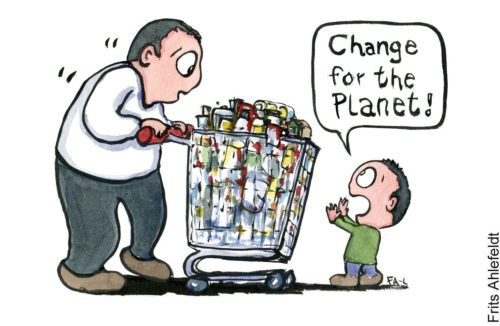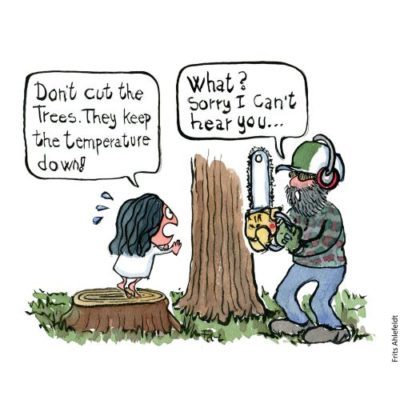Illustrations by Frits Ahlefeldt
Current situation, how the impact of climate change is being evidenced world-over
The climate is a-changing world over, and the impact is manifesting in the environment. And equally, the other way round too. Deterioration of the environment is causing pollution, depletion of the ozone layer, global warming and drastic climatic changes across the world. Greta Thunberg had thundered – we are not in the same boat, we are in a storm.
Symptoms of a ruthlessly debilitated climate/environment are listed here, a few seemingly contra-indicative. This is, however, common knowledge and visible globally.
- Severely polluted air, ambient temperature increase
- Moderate rain days decreasing (high/very high rain events doubled over last 3 yrs)
Devastating floods - Rivers running dry, desertification, droughts, water shortages
- Smoke signals – forest blazes from Brazil to Australia, from Argentina to California
- Glaciers and ice caps melting
Action campaign by community of nations

There are two narratives on climate change and action paths of mitigation and/or adaptation. The developed nations are touting solutions based on technology which created the problems in the first place. The action campaign, as it has come to pass across all nations, is briefly set out here.
Club Of Rome Report was the first warning in 1970 about limited natural resources. In 1992, Montreal Protocol was laid down to reduce greenhouse gas (GHG) emissions and phase-out
CFC. Kyoto Protocol was first agreed to in 1997 but came into effect only from 2005. USA and Australia had refused to ratify the pact. (USA had not only NOT reduced the emissions over the next 10 years but actually increased them by around 25%.)
IPCC Report of 2007 stated that the average global temperature had increased by 0.7 deg.C. Coastal lands risked submergence, the monsoon affected and crop yields projected to decline. Also, GHGs in the atmosphere had increased by 70%. CO2 level during this period had increased to 380 from 200ppm.
UN Framework Convention for Climate Change (UNFCC) was an intergovernmental treaty developed to address the problem of climate change. It sought to reduce atmospheric concentrations of greenhouse gases with the aim of preventing dangerous human interference with the Earth’s climate system. The original text in 1992 focused on six priority areas: education, training, public awareness, public participation, public access to information, and international cooperation on these issues. Yearly conventions have been held thereafter.
This opened the way for commerce in Carbon trading for countries that are unable (or do not wish to reduce) GHG emissions.
(To show up the folly in this approach, a website – stayfaithful.com – soon came up lampooning this trade. It facilitated one’s infidelity by paying someone else to remain faithful!)
Our consumptive lifestyles, deforestation, and the need for an alternative approach

The second narrative is “paramparik” (traditional) Indian wisdom pertaining to the environ. It would be pertinent, in today’s distressed times, to posit the age-old concept of revering the “panch mahabhoots” viz water, air, soil, fire and sky. This wisdom respecting nature has evolved over centuries and includes worship of rivers and trees to date. It is evident in hindsight that these beliefs led to people-based mechanisms to protect the environment, promoted by the rishis (seers) and implemented by the prajaa (citizens).
The current pandemic is a clear warning that humankind has imposed on Mother Earth a consumptive lifestyle, and debilitated Nature’s live-and-let-live scheme of things established and sustained over millennia. In the process of industrialization, development at the cost of the environment has led to the loss of diversity, air and water pollution, soil degradation, earthquakes, water stress, desertification, forest fires, tsunamis, cyclones, storms, typhoons, et al.
These changes are now understood as a result of deforestation, the rapid increase in population and irresponsible use of resources. In this context, can a US $23,000,000 toilet for women sent to the International Space Station be deemed environmentally friendly for Mother Earth?

Deforestation is the not-so-hidden cause of Air pollution and Global Warming. The rampant slashing and burning of tropical forests as a source of greenhouses gases is second only to the energy sector according to a report published today (2007) by the Oxford-based Global Canopy Programme. Trees play a vital role in keeping the oxygen, water and carbon cycles running smoothly. Scientists variously have attributed each tree a value of INR 5-10 million by way of service to mankind, “sinking” 1 ton of Carbon over a lifetime. This one “technology” nurtures soil, cleanses the air and aids monsoonal precipitation. It is imperative that ALL development minimizes the chopping of trees, and instead prioritises environmentally functional attributes like trees, bushes, mangroves, wetlands, etc. More than 50 percent of the life on Earth is in tropical forests, which cover less than 7 percent of the planet’s surface. They generate the bulk of rainfall worldwide and act as a thermostat for the Earth.
If habitats are destroyed, their inhabitants come to stay with us, to our detriment. With urbanisation squeezing forested space, come the rampaging elephants, tigers, leopards, wild boars, locusts and now bats.
If species become extinct, disruption of food chains unleashes these predatory forest denizens into our ambit leading to loss of lives and material.
Impact of the action campaign

At the UN Convention of Biological Diversity (2010), none of the 20 goals set have been met till recently. More disasters – water crisis, zoonotic diseases, earthquakes – caused by human consumption of natural resources and eradication of many species of life and plants are going to be the consequence. The reduction of bio-diversity is not sustainable. (As the story goes – the city of Hamlin suffered from uncontrolled growth of rats due to the absence of cats.)
A case in point: cows, bovine life have been identified as a big source of methane. It was only recently that US research “discovered” that adding grass to their feed reduced the emission of methane. That cows ate grass was known for centuries. The problem was created only due to a break from tradition – empirical wisdom – by industrial dairy farms for increased production.
At the 2015 climate meet in Paris, global warming was accepted as an uncontested phenomenon, likely to cause sea levels rising. Climate change implied the variation in the Earth’s climate over time, temperature rise and air pollution, in the main. Water was not a parameter of concern.
It was our Rajendra Singh (waterman of India) who helmed the strong protest and got water included as another critical vector. Water stress leads to poor hygiene and illness. Decreasing rainfall results in reduced vegetation, and dry soil and air. Desertification impacts negatively on the plant kingdom and its inhabitants.
Conclusion
The bedrock of any sustainable habitat design has to necessarily prioritise sustenance of the environment with a design philosophy that accords primacy to water and the plant kingdom.
Recalling the wisdom from Chief Seattle, a famous American Indian reproduced here in part:
Whatever befalls the Earth befalls the sons of Earth.
Man did not weave the web of life. He is merely a strand in it.
Whatever he does to the Earth he does to himself.
To harm the Earth is to heap contempt on its Creator.
We are part of the Earth. It is part of us.
Tell your children.
The time for mitigation has long gone. Pro-active and concerted efforts are imperative by each and everyone for a sustainable environment.
Else, Mother Earth is en route to becoming toast. And extinct.

4 comments
You make a valid point on the need to save centuries old grameen wisdom that were intrinsically “environment protective” and resource efficient
Coincidentally, two authors in this issue have mentioned the importance and appropriateness of centuries old grameen wisdom. Ravi Mariwala also mentions it in his article (https://fundamatics.net/the-paradox-of-sustainable-water-and-climate-change/) in an anecdote about villagers growing bhaanj trees.
Habitat Loss Habitat Gain
Forests are cut down
Biodiversity shrinks
Bats lose their habitat
Their population dwindles
So the virus loses its habitat
Looks for greener pastures
And lo! it chooses
A man from Wuhan
Jumps the species barrier
Finds the going good
Its habitat increases
Exponentially
Fifty-eight million and counting today
A sobering poem, Sunder, especially the last line. Sobering and thought-provoking, thanks for sharing.